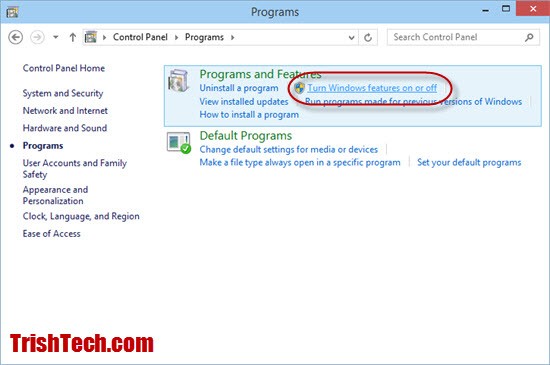Instructions for activating TFTP and Telnet Client on Windows 10
TFTP or Trivial File Transfer Protocol allows users to transfer files or transfer files from a remote computer. However, by default TFTP is disabled on Windows 10/8/7, so if you want to use TFTP you must enable the option.
Enable TFTP and Telnet Client on Windows 10
To enable TFTP and Telnet Client on Windows 10, follow the steps below:
1. Press Windows + X key combination to open the Power User menu. Here you click Control Panel to open the Control Panel window.

2. On the Control Panel window, find and click Programs.

3. On the next window, click the Turn Windows features link on or off under Programs and Features.

4. At this time, the Windows Features window appears. Here you find and select the TFTP Client and Telnet Client and click OK.

5. The activation process of Telnet and TFTP clients on Windows 10 will take some time. After finishing on the screen will display a Command Prompt window, you enter the tftp and telnet commands into it to check if these options are working properly.
Refer to some of the following articles:
- Backspace key on Windows 10 can only delete 1 character, this is how to fix it
- Summary of some ways to fix Windows 10 crash, BSOD error and restart error
- Unusually high CPU error correction due to TiWorker.exe on Windows 10 / 8.1 / 8
Good luck!
You should read it
- 5 best torrent clients for Windows
- How to activate and use SSH commands on Windows 10
- How to Set Default Email Client in Windows 11
- DNSCrypt client for Windows: Encrypt data from computer to DNS
- How to set up the default email client on Windows 10
- How to configure NTP Server and NTP Client in Windows Server 2019
 Instructions for linking Windows 10 Product key to Microsoft account
Instructions for linking Windows 10 Product key to Microsoft account 3 ways to set up different background images on each Windows 10 screen
3 ways to set up different background images on each Windows 10 screen Fix the error of not adjusting screen brightness on Windows 10
Fix the error of not adjusting screen brightness on Windows 10 How to check if your computer is running Windows 10 Hyper-V?
How to check if your computer is running Windows 10 Hyper-V? Automatically 'clean up' the Recycle Bin on Windows 10
Automatically 'clean up' the Recycle Bin on Windows 10 How to fix 'An operating system not found' error on Windows 10 and Windows 8.1
How to fix 'An operating system not found' error on Windows 10 and Windows 8.1